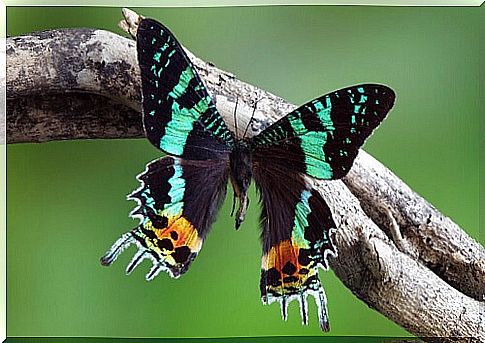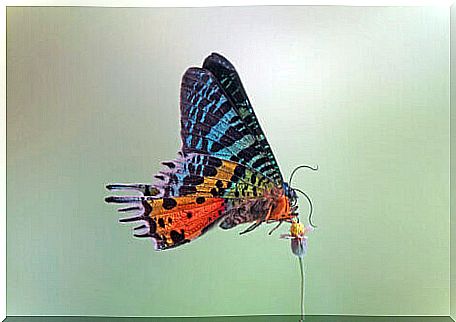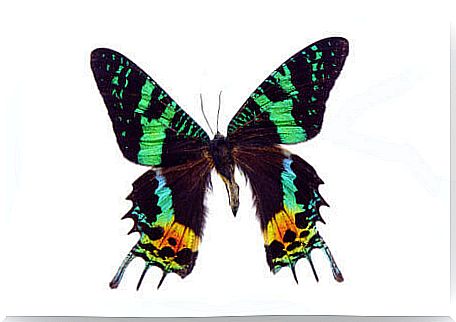The Urania Of Madagascar, One Of The Most Beautiful Moths In The World

The Madagascar urania ( Chrysiridia rhipheus) belongs to the order of the Lepidoptera and to the family Uraniidae. This species of moth is characterized by a peculiarity that attracts the interest of the locals: its iridescence.
The colored motifs on the wings of this diurnal moth are rather unusual, with a metallic color and a characteristic iridescence also present in the ventral area. If you want to know more about Madagascar’s wonderful urania, this is the article for you.
The Madagascar urania is part of a large family
Insects of the order of Lepidoptera, including butterflies and moths, are the second most important pollinators on the planet. The trait that unites them all are the four vital phases passed through to achieve development.
All moths experience a metamorphosis and, as a primary food source, feed on the shells of their own egg. There is a great variety of these insects in the world, with as many as 20,000 different species and an incredible diversity of shapes and colors. Their dimensions can vary from four centimeters up to twelve centimeters in wingspan.
Lepidoptera also share other characteristics, such as the ability to see only 3 different colors: red, green and yellow. However, the morphological and physiological traits that distinguish them allow them to recognize themselves among different specimens belonging to the order.

An iridescent moth
It is interesting to note how the most peculiar trait of this moth, its iridescence, is due to an optical effect generated by the reflection of light on its wings.
Color schemes in animals are generally produced by the distribution of pigments of different colors. On the contrary, in the case of the urania of Madagascar we are faced with a phenomenon known as structural coloring.
The visual effect is not given by the pigmentation of the wing. These are in fact covered with very small scales of different shapes and sizes, which by moving produce color.
The light reflects on these microstructures forming an arc made up of the 7 essential colors. Depending on the angle from which you observe them, the wings reflect different shades of colors.
The coloring of Madagascar urania is under study
The structural coloring of urania of Madagascar is the object of research of many scholars. Its wings possess a periodic microstructure on a submicronic scale, responsible for its iridescence. The morphology of the scales and the spatial variation of the microstructure are interesting examples of physical phenomena such as interference and diffraction.
Distribution and diet
Madagascar urania is an insect endemic to Madagascar. This is due to its strong relationship with plants of the Omphalea genus , which thrive on the island.
During the caterpillar phase, its diet is specialized as it feeds exclusively on plants existing in Madagascar , specifically the ankarenensis, palmata, occidentalis and oppositifolia species . In adulthood it becomes a generalist species, feeding on the nectar of a wide variety of plants.
Although as an adult it no longer depends on plants of the Omphalea genus , the moth never strays too far from them. In fact, the survival of its larva depends on their presence. Furthermore, the adult Madagascar urania lays its eggs exclusively in the lower part of the leaves of these plants.

One last secret weapon
As we have seen, once the eggs hatch and the larvae emerge, the caterpillars feed on the Omphalea plants , which provide them with nourishment and chemical defenses. This plant species, in fact, produces a powerful toxin which, if ingested by the larva, remains inside its body for life.
Curiously, the caterpillar consumes the plant and almost instantly uses the toxins to defend itself against potentially pathogenic ants residing on the same plant.
These ants, which typically attack insects that try to feed on the plant, leave the toxin-secreting larva alone. During the pupa phase and the adult phase, Madagascar urania stops producing the toxin constantly, conserving it instead for when it is forced to defend itself from a predator.









